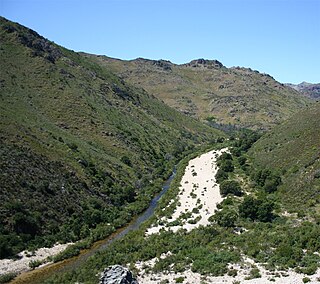
Lake Tana is the largest lake in Ethiopia and the source of the Blue Nile. Located in Amhara Region in the north-western Ethiopian Highlands, the lake is approximately 84 kilometres long and 66 kilometres wide, with a maximum depth of 15 metres, and an elevation of 1,788 metres. Lake Tana is fed by the Gilgel Abay, Reb and Gumara rivers. Its surface area ranges from 3,000 to 3,500 square kilometres, depending on season and rainfall. The lake level has been regulated since the construction of the control weir where the lake discharges into the Blue Nile. This controls the flow to the Blue Nile Falls and hydro-power station.

The Olifants River is a river in the northwestern area of the Western Cape Province of South Africa. The upper and main catchment area of the Olifants river is around Ceres and the Cederberg mountains. The Clanwilliam and Bulshoek dams are located on the river and provide water for the towns and farms along the watercourse. The river is approximately 285 km long with a catchment area of 46,220 km2 and flows into the Atlantic Ocean at Papendorp, 250 km north of Cape Town.

Trees was a British folk rock band recording and touring throughout 1969, 1970 and 1971, reforming briefly to continue performing throughout 1972. Although the group met with little commercial success in their time, the reputation of the band has grown over the years, and underwent a renaissance in 2007 following Gnarls Barkley's sampling of the track "Geordie" on the title track of their multi-million selling album St. Elsewhere.

The Ripon barbel is an East African ray-finned fish species in the family Cyprinidae. A notably large barb, its maximum recorded total length is 90 cm (35 in).

The Clanwilliam yellowfish is a ray-finned fish species in the family Cyprinidae. It has long been placed in Barbus, the "wastebin genus" for barbs, by default; however, the species is increasingly being restored to related yellowfish genus Labeobarbus which seems a much more appropriate placement. It is hexaploid like the other yellowfish, among which it is more closely related to the smallscale yellowfish than to the largescale yellowfish.
Labeobarbus johnstonii is a species of cyprinid fish. It has long been placed in Barbus, the "wastebin genus" for barbs, by default, and this is still being done by the IUCN. However, the species is increasingly being restored to related yellowfish genus Labeobarbus which seems a much more appropriate placement. It is presumably hexaploid like the other yellowfish. The supposed subspecies latirostris of its relative L. intermedius is actually misidentified L. johnstonii.

The largemouth yellowfish or Vaal-Orange largemouth yellowfish is a ray-finned fish species in the family Cyprinidae. This large freshwater barb is found in southern Africa.

The Pangani barb is a species of cyprinid fish.

Labeobarbus somereni, or Someren's barb, is a species of ray-finned fish in the family Cyprinidae. It is found in Burundi, Rwanda, Tanzania, and Uganda. Its natural habitat is rivers. It is not considered a threatened species by the IUCN. Local names for the fish in Rwanda include ikinanga, inkwenwe, ifurwe (Satinsyi) and urwozi (Nyabarongo).
Labeobarbus tropidolepis is a species of ray-finned fish in the family Cyprinidae. It is found in Burundi and Tanzania where it is endemic to the Lake Tanganyika basin. Its natural habitats are rivers, freshwater lakes, freshwater marshes, and inland deltas. It is not considered a threatened species by the IUCN.

Labeobarbus is a mid-sized ray-finned fish genus in the family Cyprinidae. Its species are widely distributed throughout eastern Africa and especially southern Africa, but also in Lake Tana in Ethiopia. A common name, in particular for the southern species, is yellowfish. The scientific name refers to the fact that these large barbs recall the fairly closely related "carps" in the genus Labeo in size and shape. As far as can be told, all Labeobarbus species are hexaploid.

The largescale yellowfish or Lowveld largescale yellowfish is a species of fish in the family Cyprinidae. An African freshwater fish found from the Zambezi south to the Pongola River.

The scaly yellowfish, or KwaZulu-Natal yellowfish, is a species of freshwater fish in the family Cyprinidae.

Labeobarbus bynni, the Niger barb, is an African species of cyprinid freshwater fish. It has often been placed in the genus Barbus, but is now usually placed in Labeobarbus. This is a relatively large barb, up to 82 cm (32 in) in total length. It is caught as a food fish, but catches can vary greatly from year to year.

Labeobarbus mirabilis is a species of ray-finned fish in the genus Labeobarbus. Its type locality is the Ituri River, near Mawambi, Ituri Province, Democratic Republic of the Congo. It has not been found in other locations. This species was initially placed in the genus Barbus, but is now considered to be a member of Labeobarbus. Some experts have raised the possibility that, with more research, L. mirabilis might become classified as a junior synonym of L. somereni.
Cathryn Humphris is an American television writer. She has worked on the AMC drama Mad Men and has won a Writers Guild of America (WGA) Award.

Melrose is a suburb of Wellington, New Zealand. It is south of the city centre, Berhampore and Newtown, and is in the Eastern Ward. Although adjacent to Lyall Bay, it does not have seafront access to the bay.
The 1887 Te Aro by-election was a by-election held in the single-member Te Aro electorate during the 8th New Zealand Parliament, on 15 April 1887.
Debra Humphris is an English academic and nurse who has been the vice chancellor of the University of Brighton since 2015.
Susan Humphris is a geologist known for her research on processes at mid-ocean ridges. She is an elected fellow of the American Geophysical Union.












